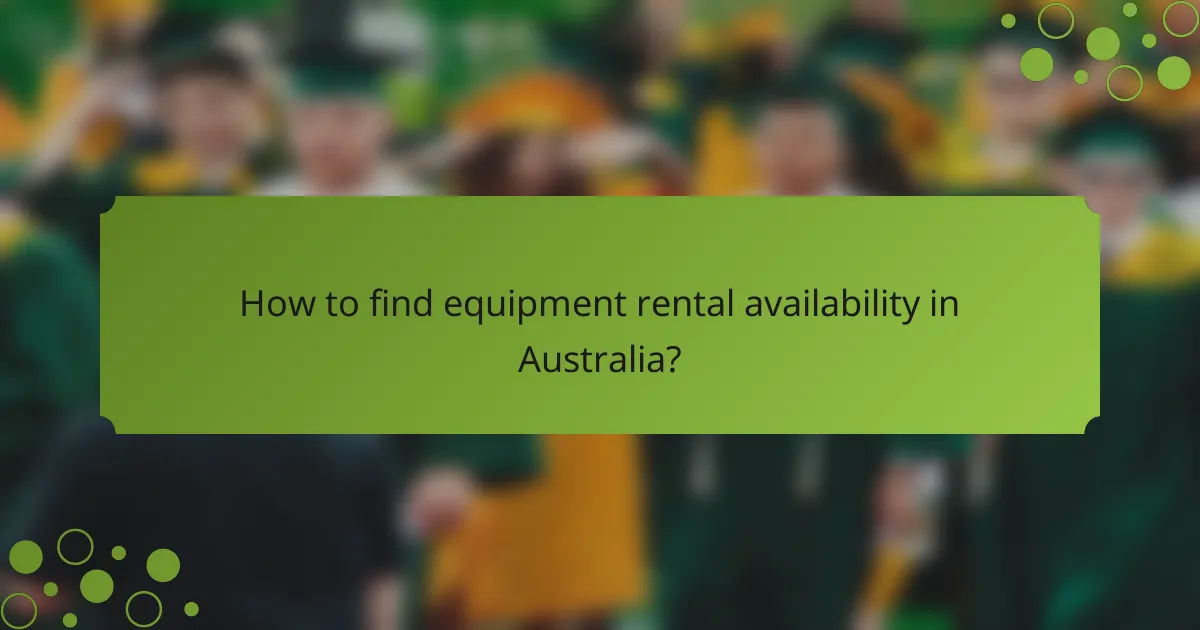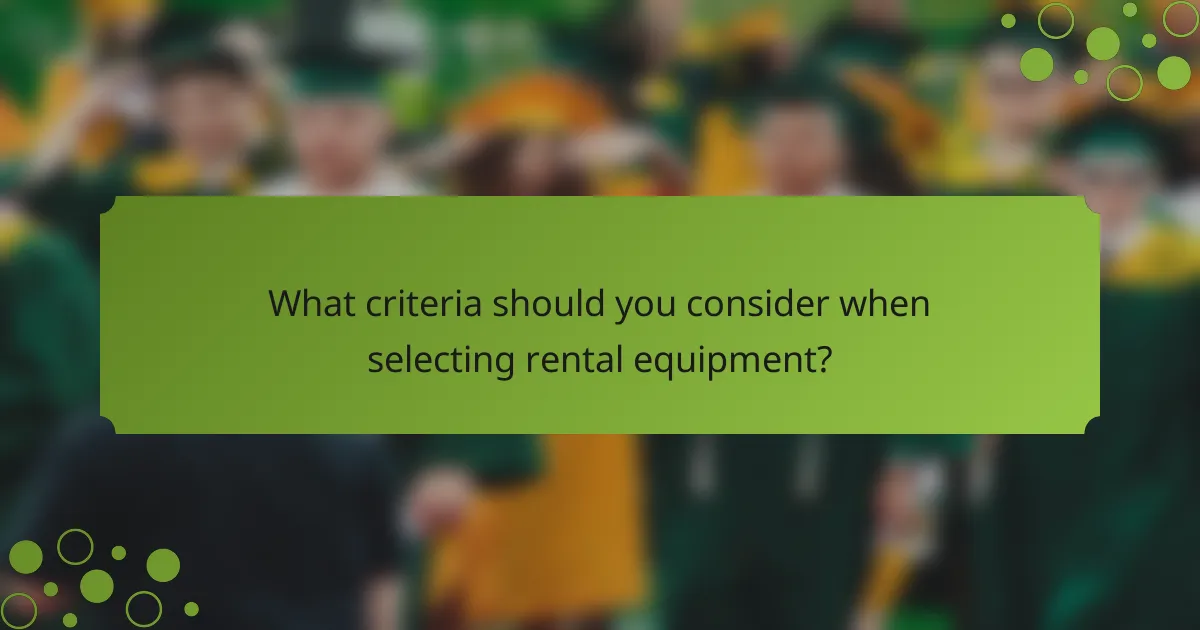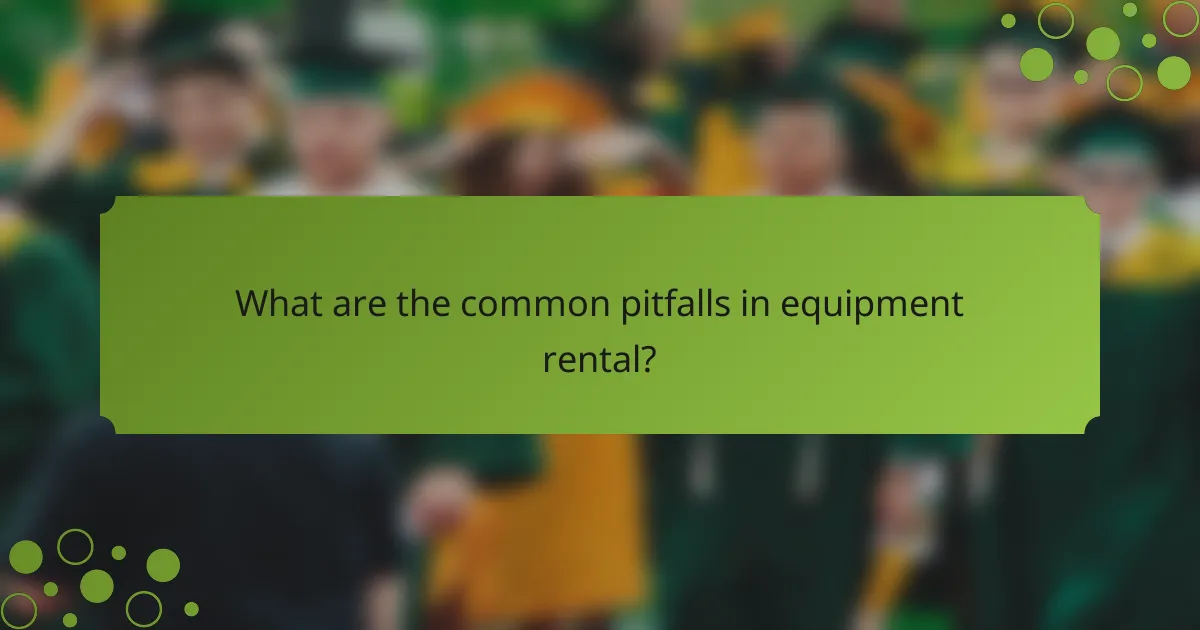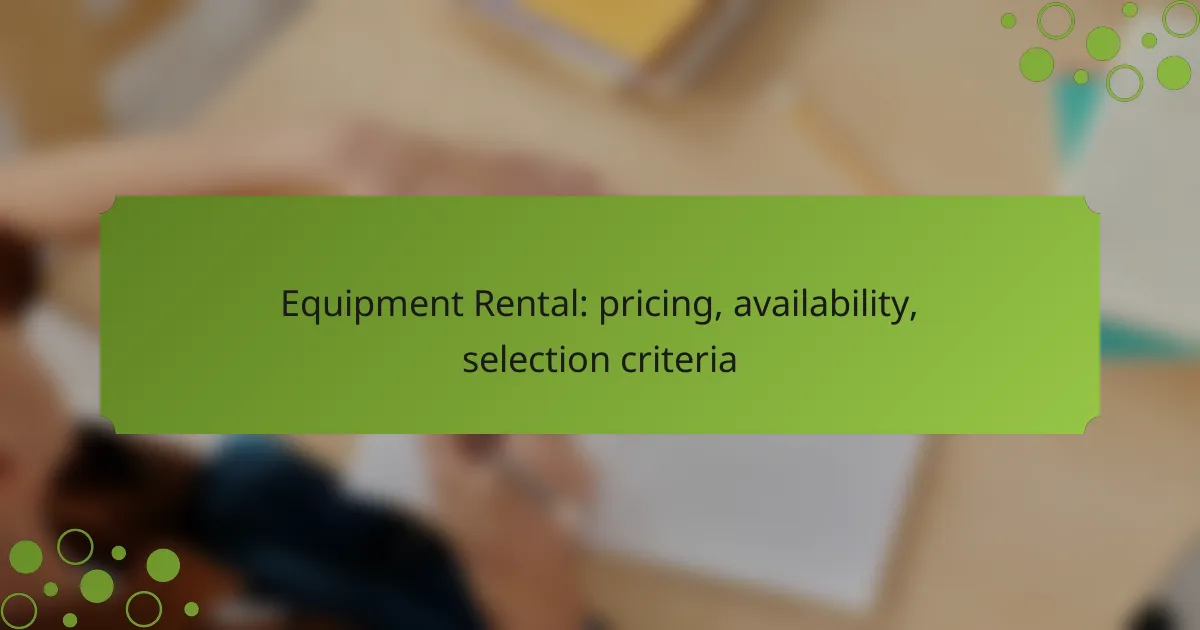When renting equipment in Australia, it’s essential to understand the pricing, availability, and selection criteria to make informed decisions. Rental costs can vary widely depending on the type of equipment and rental duration, with smaller items typically starting in the low tens of AUD per day. To find available options, utilize online platforms and local rental shops that provide up-to-date stock information. Additionally, consider factors such as equipment specifications and insurance options to ensure you select the right equipment for your needs.

What is the average equipment rental pricing in Australia?
The average equipment rental pricing in Australia varies significantly based on the type of equipment, rental duration, and location. Generally, rental costs can range from low tens of AUD per day for smaller items to several hundred AUD for larger, specialized machinery.
Pricing for construction equipment
Construction equipment rental prices in Australia typically range from around AUD 100 to AUD 1,000 per day, depending on the machinery type. Commonly rented items include excavators, bulldozers, and scaffolding, with larger machines commanding higher rates.
When renting construction equipment, consider the rental duration, as many companies offer discounts for longer terms. Always check for additional costs such as delivery fees, insurance, and fuel charges, which can affect the total rental price.
Pricing for party supplies
Party supplies rental prices can vary widely, generally falling between AUD 50 and AUD 500, depending on the items needed. Common rentals include tables, chairs, tents, and decorations, with larger items like marquees costing more.
To save on costs, consider renting multiple items from the same supplier, as many offer package deals. Additionally, booking in advance can help secure better rates and availability, especially during peak seasons.
Pricing for audiovisual equipment
Audiovisual equipment rental in Australia usually ranges from AUD 100 to AUD 1,500 per day, based on the complexity and quality of the equipment. Common rentals include projectors, sound systems, and lighting setups, with high-end gear attracting premium prices.
When renting audiovisual equipment, ensure you understand the technical requirements for your event. It’s advisable to consult with rental companies about your specific needs to avoid overspending on unnecessary equipment or features.

How to find equipment rental availability in Australia?
To find equipment rental availability in Australia, start by checking online platforms and local rental shops. These resources provide current stock levels and can help you compare prices and options quickly.
Online rental platforms
Online rental platforms like Hirepool, Kennards Hire, and EquipmentShare offer a wide range of equipment for various needs. These websites typically allow you to search by location, equipment type, and rental duration, making it easy to find what you need.
When using these platforms, pay attention to user reviews and ratings to gauge the reliability of the equipment and service. Additionally, many platforms provide real-time availability, ensuring you can secure your rental without delays.
Local rental shops
Local rental shops can be a valuable resource for finding equipment in your area. These shops often have knowledgeable staff who can assist you in selecting the right equipment based on your specific project requirements.
Visiting local shops allows you to inspect the equipment before renting, which can help you avoid issues related to quality or suitability. It’s also worth asking about any special promotions or discounts that may not be advertised online.
Seasonal availability trends
Equipment availability can fluctuate seasonally, especially for items like landscaping tools or construction machinery. During peak seasons, such as summer for outdoor projects, demand may exceed supply, leading to limited options.
To navigate these trends, plan your rentals ahead of time, especially for high-demand periods. Consider booking equipment during off-peak times when prices may be lower and availability higher.

What criteria should you consider when selecting rental equipment?
When selecting rental equipment, consider factors such as equipment specifications, rental duration, and insurance options. Each of these criteria plays a crucial role in ensuring that you choose the right equipment for your specific needs and budget.
Equipment specifications
Equipment specifications include the type, size, and capabilities of the machinery or tools you need. Assess whether the equipment meets the demands of your project, such as weight capacity, power output, and compatibility with existing tools.
For example, if you need a generator, consider its wattage output and fuel type. Ensure it aligns with your power requirements and operational preferences. Always check the manufacturer’s guidelines to confirm that the equipment is suitable for your intended use.
Rental duration
Rental duration significantly impacts pricing and availability. Determine how long you will need the equipment, as rental rates often vary based on daily, weekly, or monthly terms. Longer rental periods typically offer better rates.
For instance, a daily rental might cost $100, while a weekly rental could be $500. Compare these options to find the most cost-effective solution for your project timeline. Be mindful of any additional fees for late returns or early pickups.
Insurance options
Insurance options are essential to protect against potential damages or loss during the rental period. Many rental companies offer insurance packages that cover various scenarios, including theft, accidental damage, and liability.
Evaluate the cost of insurance against the value of the equipment and the risks involved. For high-value items, opting for comprehensive coverage may be wise. Always read the terms carefully to understand what is included and any deductibles that may apply.

What are the benefits of renting equipment versus buying?
Renting equipment offers significant advantages over purchasing, particularly in terms of cost, flexibility, and access to modern technology. Businesses can save money and adapt to changing needs more easily by choosing to rent rather than buy equipment outright.
Cost savings
One of the primary benefits of renting equipment is the potential for substantial cost savings. Renting eliminates the need for large upfront investments, allowing businesses to allocate funds to other critical areas. Additionally, rental agreements often include maintenance and repair costs, reducing unexpected expenses.
For example, if a construction company needs a crane for a short-term project, renting may cost a few hundred to a couple of thousand dollars, while purchasing the same crane could require tens of thousands of dollars. This makes renting a more financially viable option for short-term needs.
Flexibility in usage
Renting equipment provides businesses with the flexibility to choose the right tools for specific projects without long-term commitments. This adaptability allows companies to scale their operations up or down based on demand, ensuring they only pay for what they need when they need it.
For instance, a landscaping company may rent specialized equipment for seasonal projects and return it once the job is complete, avoiding the hassle of storing unused equipment during off-peak times. This flexibility can enhance operational efficiency and responsiveness.
Access to the latest technology
Renting equipment allows businesses to access the latest technology without the burden of ownership. Rental companies often update their inventory to include the newest models and features, enabling users to benefit from advancements in efficiency and performance.
For example, a film production company can rent the latest camera equipment with advanced features that improve video quality, which may not be feasible to purchase outright. This access to cutting-edge technology can enhance the quality of work and keep businesses competitive in their respective industries.

How do rental agreements work in Australia?
Rental agreements in Australia are contracts that outline the terms under which equipment is rented. They specify the rights and responsibilities of both the renter and the rental company, including duration, costs, and conditions for use.
Standard terms and conditions
Standard terms and conditions in rental agreements typically cover the rental period, payment terms, and usage restrictions. These agreements often include clauses regarding maintenance responsibilities, liability for damages, and insurance requirements.
It’s essential to read these terms carefully, as they can vary significantly between rental companies. For example, some may require renters to return equipment in the same condition it was received, while others may include wear and tear allowances.
Deposit requirements
Most rental companies in Australia require a security deposit before handing over equipment. This deposit serves as a safeguard against potential damages or late returns and is usually a percentage of the rental cost or a fixed amount.
Deposits can range from a few hundred AUD to several thousand, depending on the equipment’s value. Ensure you understand the deposit policy, including how and when it will be refunded after the rental period.
Return policies
Return policies dictate how and when rented equipment must be returned. Many companies require equipment to be returned by a specific time on the due date, with penalties for late returns.
Some rental agreements may offer flexible return options, such as extended rental periods or drop-off locations. Always clarify the return policy to avoid unexpected fees or complications.

What are the common pitfalls in equipment rental?
Common pitfalls in equipment rental include unexpected costs, limited availability, and inadequate selection criteria. Being aware of these issues can help you make informed decisions and avoid costly mistakes.
Hidden fees
Hidden fees are additional charges that may not be clearly disclosed upfront, leading to unexpected costs. These can include delivery fees, cleaning charges, or insurance costs that significantly increase the total rental price.
To avoid hidden fees, always read the rental agreement carefully and ask the provider to clarify any ambiguous terms. It’s wise to request a detailed breakdown of all potential charges before finalizing the rental.
Common hidden fees can range from 10% to 30% of the base rental cost, so budgeting for these can prevent surprises. Always confirm whether the quoted price includes taxes and any additional costs to ensure you are fully informed.
